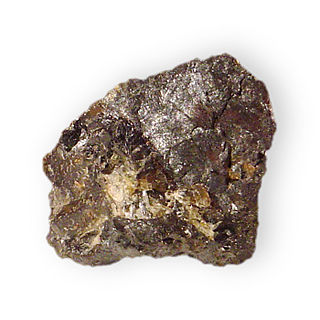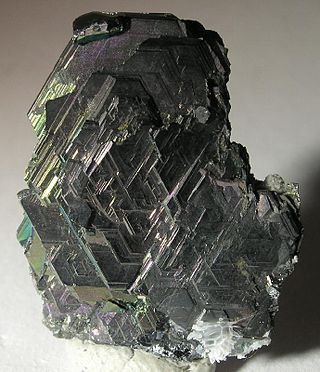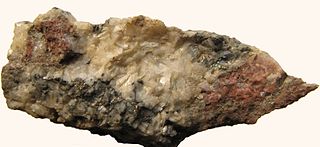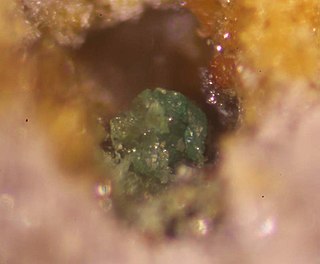
Kobellite is a gray, fibrous, metallic mineral with the chemical formula Pb22Cu4(Bi,Sb)30S69. It is also a sulfide mineral consisting of antimony, bismuth, and lead. It is a member of the izoklakeite – berryite series with silver and iron substituting in the copper site and a varying ratio of bismuth, antimony, and lead. It crystallizes with monoclinic pyramidal crystals. The mineral can be found in ores and deposits of Hvena, Sweden; Ouray, Colorado; and Wake County, North Carolina, US. The mineral was named after Wolfgang Franz von Kobell (1803–1882), a German mineralogist.

Stibnite, sometimes called antimonite, is a sulfide mineral with the formula Sb2S3. This soft grey material crystallizes in an orthorhombic space group. It is the most important source for the metalloid antimony. The name is derived from the Greek στίβι stibi through the Latin stibium as the former name for the mineral and the element antimony.

Zinkenite is a steel-gray metallic sulfosalt mineral composed of lead antimony sulfide Pb9Sb22S42. Zinkenite occurs as acicular needle-like crystals.

Ullmannite or Nickel glance is a nickel antimony sulfide mineral with formula: NiSbS. Considerable substitution occurs with cobalt and iron in the nickel site along with bismuth and arsenic in the antimony site. A solid solution series exists with the high cobalt willyamite.

Valentinite is an antimony oxide mineral with formula Sb2O3. Valentinite crystallizes in the orthorhombic system and typically forms as radiating clusters of euhedral crystals or as fibrous masses. It is colorless to white with occasional shades or tints of yellow and red. It has a Mohs hardness of 2.5 to 3 and a specific gravity of 5.76. Valentinite occurs as a weathering product of stibnite and other antimony minerals. It is dimorphous with the isometric antimony oxide senarmontite.

Geocronite is a mineral, a mixed sulfosalt containing lead, antimony, and arsenic with a formula of Pb14(Sb, As)6S23. Geocronite is the antimony-rich endmember of a solid solution series. The arsenic-rich endmember is named jordanite. It occurs as grey, black, to silvery white monoclinic crystals. It is found in hydrothermal veins usually associated with other similar minerals, particularly the sulfides of iron and copper.

Jamesonite (also axotomous antimony glance, domingite, comuccite, pfaffite, grey antimony or feather ore) is a sulphosalt mineral, a lead, iron, antimony sulphide with formula Pb4FeSb6S14. With the addition of manganese it forms a series with benavidesite. It is a dark grey metallic mineral which forms acicular prismatic monoclinic crystals. It is soft with a Mohs hardness of 2.5 and has a specific gravity of 5.5 – 5.6. It is one of the few sulphide minerals to form fibrous or needle like crystals. It can also form large prismatic crystals similar to stibnite with which it can be associated. It is usually found in low to moderate temperature hydrothermal deposits.

Polybasite is a sulfosalt mineral of silver, copper, antimony and arsenic. Its chemical formula is [(Ag,Cu)6(Sb,As)2S7][Ag9CuS4].

Berthierite is a mineral, a sulfide of iron and antimony with formula FeSb2S4. It is steel grey in colour with a metallic lustre which can be covered by an iridescent tarnish. Because of its appearance it is often mistaken for stibnite.

Kermesite or antimony oxysulfide is also known as red antimony or purpur blende (Sb2S2O). The mineral's color ranges from cherry red to a dark red to a black. Kermesite is the result of partial oxidation between stibnite (Sb2S3) and other antimony oxides such as valentinite (Sb2O3) or stibiconite (Sb3O6(OH)). Under certain conditions with oxygenated fluids the transformation of all sulfur to oxygen would occur but kermesite occurs when that transformation is halted.

Antimony triselenide is the chemical compound with the formula Sb2Se3. The material exists as the sulfosalt mineral antimonselite, which crystallizes in an orthorhombic space group. In this compound, antimony has a formal oxidation state +3 and selenium −2. The bonding in this compound has covalent character as evidenced by the black color and semiconducting properties of this and related materials. The low-frequency dielectric constant (ε0) has been measured to be 133 along the c axis of the crystal at room temperature, which is unusually large. Its band gap is 1.18 eV at room temperature.

Stibiopalladinite is a mineral containing the chemical elements palladium and antimony. Its chemical formula is Pd5Sb2. It is a silvery white to steel grey opaque mineral crystallizing in the hexagonal crystal system.

Stibiconite, also formerly known as antimony ochre is an antimony oxide mineral with formula: Sb3O6(OH). Its name originates from Greek stíbi (στίβι), 'antimony' and kónis (κόνις), 'powder', alluding to its composition and habit. It is a member of the pyrochlore super group.

Biehlite is an exceptionally rare mineral, an antimony arsenic bearing molybdate with formula [(Sb,As)O]2MoO4. It comes from Tsumeb.

Semseyite is a rarely occurring sulfosalt mineral and is part of the class of lead antimony sulfides. It crystallizes in the monoclinic system with the chemical composition Pb9Sb8S21. The mineral forms dark gray to black aggregates.

Tripuhyite is an iron antimonate mineral with composition FeSbO4.

Stibarsen or allemontite is a natural form of arsenic antimonide (AsSb) or antimony arsenide (SbAs). The name stibarsen is derived from Latin stibium (antimony) and arsenic, whereas allemontite refers to the locality Allemont in France where the mineral was discovered. It is found in veins at Allemont, Isère, France; Valtellina, Italy; and the Comstock Lode, United States; and in a lithium pegmatites at Varuträsk, Sweden. Stibarsen is often mixed with pure arsenic or antimony, and the original description in 1941 proposed to use stibarsen for AsSb and allemontite for the mixtures. Since 1982, the International Mineralogical Association considers stibarsen as the correct mineral name.
Szklaryite is an extremely rare mineral with the formula []Al6BAs33+O15. It is essentially vacant ("[]"), arsenic-dominant member of dumortierite supergroup, giving a name of szklaryite group. It is one of three quite recently found minerals of this group, the other two being nioboholtite and titanoholtite, all coming from the Szklary village near Ząbkowice Śląskie in Poland. They occur in a unique pegmatite of probable anatectic origin.
Nioboholtite is an extremely rare mineral with the formula (Nb0.6[]0.4)Al6BSi3O18. It is the niobium-rich member of the dumortierite supergroup, and the niobium analogue of holtite of the holtite group. It is one of three quite recently found minerals of this group, the other two being titanoholtite and szklaryite, all coming from the Szklary village near Ząbkowice Śląskie in Poland. They occur in a unique pegmatite. Nioboholtite and schiavinatoite are both minerals with essential niobium and boron.
Peretaite is a sulfate of antimony and calcium. The mineral, Ca(SbO)4(SO4)2(OH)2 (2(H2O)), was named Peretaite for its locality. It was first discovered in an antimony-bearing vein at Pereta, Tuscany, Italy.

















